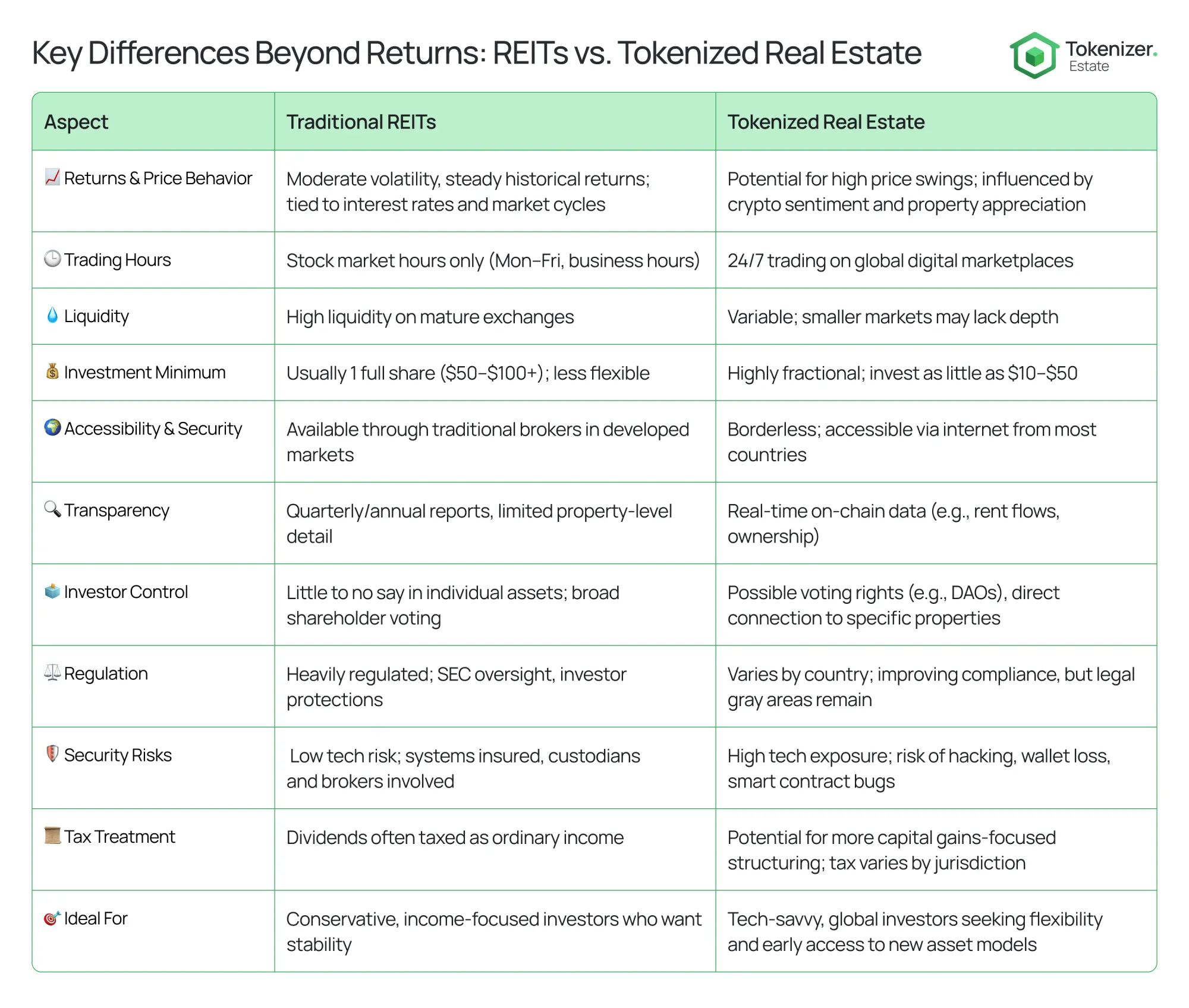Tokenized Real Estate vs. REITs: 2025 Total-Return Showdown
In 2025, real estate investing faces a fresh face-off: classic REITs with steady dividends vs. tokenized properties powered by blockchain. This article compares total returns, payout styles, and risks—so you can see where the smarter yield may be hiding this year.

The world of real estate investing is witnessing a showdown in 2025. On one side stand traditional Real Estate Investment Trusts (REITs), long favored for their stable dividends and established track record. On the other side is tokenized real estate, a newcomer leveraging blockchain technology to turn properties into digital tokens. Investors globally – from the United States to Europe, Asia, and the Middle East – are watching this trend closely. They want to know which approach can deliver better returns in 2025, and how dividend payouts from REITs stack up against rental income from real estate tokens. This article breaks down the comparison in simple terms, looking at both total returns and key differences between REITs and tokenized property investments.
What Are REITs?

REITs are companies that own or finance income-producing real estate. When you buy shares of a REIT, you are buying a slice of a large real estate portfolio – it could include offices, apartments, malls, or hotels. Investors like REITs because they provide steady dividend income. By law (in many countries like the U.S.), REITs must pay out around 90% of their taxable income as dividends. This means if a REIT earns rent from properties, most of those earnings flow to shareholders as regular dividends. REIT shares are traded on stock exchanges, making them relatively liquid (easy to buy and sell during market hours).
REITs have been around for decades and have grown very large. In the United States alone, REITs manage over $1.5 trillion in assets. They are popular with income-focused investors because of their reliable payouts and regulatory protections. For instance, a typical U.S. equity REIT today yields about 3.5–4% in annual dividends. This yield is significantly higher than the average stock in the S&P 500 index. In some markets, REIT yields can be even higher – for example, Dubai-based REITs offer around 6–8% dividend yields in 2025, above the global average. Investors in volatile times are naturally drawn to these defensive, income-generating assets delivering mid-single-digit yields. However, with a REIT you do not own a specific property outright; you own a share of the fund. Your returns come from dividends and any change in the REIT’s share price (which can rise if property values go up, or fall if the market struggles).
What Is Tokenized Real Estate?

Tokenized real estate uses blockchain technology to turn a property’s ownership into digital tokens. In simple terms, a building or a house is divided into many small pieces, and each piece is represented by a token on a blockchain. If you buy those tokens, you become a fractional owner of the property. This concept is similar to crowdfunding a property, but with the added benefits of blockchain – like 24/7 trading and transparent records. Tokenization allows even small investors to invest in real estate globally. For example, instead of needing tens of thousands of dollars to buy a house, an investor could buy a $50 or $100 token that represents a share in an apartment building. As one 2025 report describes, “a single apartment or office can be sliced into thousands of blockchain-based tokens — each one representing a piece of ownership”. This means anyone with an internet connection can potentially invest, whether they live in New York or New Delhi.
One big appeal of tokenized real estate is that rental income can be distributed directly to token holders. These payouts often happen in stablecoins (cryptocurrencies pegged to the dollar, like USDC) and can occur monthly or even daily rather than quarterly . For instance, if a token represents a share of an apartment building, the rent collected from tenants is pooled and then automatically paid out to token holders’ digital wallets. This is powered by smart contracts – self-executing code on the blockchain – which handle distributions and record ownership without needing traditional bank transfers or paperwork. In some cases, token holders can even vote on property decisions (like approving a renovation or choosing a property manager), giving a sense of direct control that REIT shareholders typically don’t have. Essentially, tokenization is making real estate investment more personal and transparent for a new generation of investors.
It’s important to note that tokenized real estate is very new and rapidly evolving. As of mid-2025, the total market for tokenized properties was still small (around $1.2 billion in global volume) compared to the multi-trillion-dollar traditional real estate market. But it is growing fast – up from roughly $200 million in 2023 – and gaining attention. Even large financial institutions have taken note. Larry Fink, CEO of BlackRock, famously said that asset tokenization “is not a question of if, but when. And it’s already happening faster than most people realize.” This highlights a rising belief that tokenized assets could become mainstream in the near future.
Comparing Returns: 2025 Showdown on Total Returns
The crux of the 2025 showdown is: which investment can give better total returns – REITs or tokenized real estate? Total return means the combination of income (dividends or rent) and capital appreciation (increase in the value of the share or token).
Dividend Income vs. Rental Payouts

REIT investors earn income through dividend payments. In 2025, REIT dividend yields are healthy but moderate. Analysts expected about 8–10% total return for REITs in 2025, with roughly half of that coming from cash dividends (around a ~4% yield). Indeed, many REITs currently yield in the 3-4% range annually in markets like the U.S.. This means if you invested $1,000 in a typical REIT, you might get around $35–$40 in dividends over a year (plus any change in the share price). REIT dividends are usually paid quarterly and are a major reason people invest in them – they provide steady, passive income.
Tokenized real estate, on the other hand, often distributes rental income payouts to token holders. Because tokenized projects can target specific properties or niche markets, their yields can be quite attractive. Some blockchain real estate platforms have been providing 8–12% annualized returns to investors. This is notably higher than the average REIT yield. For example, one tokenized property offering in Dubai advertised a 7.4% projected rental yield for token holders. What that means is if you held $1,000 worth of those property tokens, you could expect around $74 per year in rental distributions, typically paid monthly in stablecoin. These token rent payouts can be thought of as analogous to REIT dividends – but often paid more frequently. We have discussed in detail what makes up the profitability of tokenized real estate - from the growth of the token price to regular rental payments - in a separate article.
Figure: Comparing typical annual income yields – REIT dividends vs. tokenized real estate rental payouts in 2025. REITs in mature markets yield roughly 4%, while some tokenized properties target around 8–12%.
| Aspect | REITs (2025) | Tokenized Real Estate (2025) |
|---|---|---|
| Annual Income Yield | ~4% (quarterly dividends) | 8–12% (monthly rental payouts) |
| Total Return Potential | 8–10% (dividends + price gains) | Often higher, but varies by project |
| Capital Appreciation | Moderate; tied to property & stock market | Potentially high; linked to property value & token demand |
| Volatility | Lower; relatively stable, regulated | Higher; trades 24/7, influenced by crypto markets |
| Payout Frequency | Quarterly dividends | Often monthly in stablecoin |
| Transparency | Audited, regulated reporting | On-chain data, platform-dependent |
Why are token yields often higher? One reason is efficiency and risk. Tokenized projects can cut out many middlemen (no large corporate overhead or big management fees), potentially passing more income to investors. They also might involve properties or markets that traditional REITs avoid – for instance, smaller residential properties or emerging markets that can have higher rental yields. However, higher yield often comes with higher risk. New token projects might not have the stable occupancy or long track record that established REIT portfolios have. There may be periods with no tenants or unexpected costs, which could reduce payouts. Moreover, because tokenized real estate is new, some platforms choose to structure returns differently – sometimes focusing on price appreciation of the token rather than regular income. In such cases, an investor might not get large monthly rent checks, but the token’s value could rise over time if the underlying property value grows or if demand for the tokens increases.
Capital Appreciation and Price Volatility
Beyond the yield, investors care about the change in the value of their investment. For REITs, the share price can move with the real estate market and broader stock market sentiment. In 2025, REIT performance has been mixed. For example, in the first half of 2025, U.S. equity REITs delivered a modest +1.8% total return (including dividends), as rising interest rates and other economic factors kept prices in check. Analysts remain cautiously optimistic that, with steady economic growth, REITs can finish the year with high single-digit returns in line with historical averages. REIT prices tend to be influenced by factors like interest rates (higher rates can pressure REIT prices down, since investors then demand higher yields) and property market conditions. Still, REITs are considered relatively stable compared to many stocks – they own tangible assets and have long-term leases generating income.
For tokenized real estate, the price of the tokens can also appreciate if the underlying property value increases or if more investors want the tokens. For instance, if a token represents a share in a building and that building’s market value goes up 10%, theoretically the token’s price should rise as well. In practice, token prices can be volatile. They trade on digital exchanges, sometimes influenced by crypto market sentiment. This means token values might swing more quickly than REIT stock prices. On the positive side, token markets run 24/7 globally, so an owner can respond to news or sell anytime, not just during stock market hours. The flip side is that during off-hours or in smaller token markets, liquidity can be low – there may not be a buyer at a fair price when you want to sell, leading to more price volatility. A token’s price could drop sharply if there’s negative news about the property or platform, or spike if a particular token sale goes viral on social media.
It’s also worth noting that while REITs are well-regulated and audited, giving investors confidence in reported asset values, tokenized assets rely on the integrity of the platform and smart contracts. In 2025, many token platforms are working on providing real-time transparency – for example, anyone can verify the rent distributions and ownership stakes on-chain . This level of transparency can actually increase trust and potentially support token values, since investors can see the cash flows backing their investment in real time.
Key Differences Beyond Returns

Aside from the pure return numbers, REITs and tokenized real estate differ in liquidity, access, transparency, and regulation. Here are some key differences at a glance:
Liquidity and Trading Hours
REIT shares trade on stock exchanges with limited hours (e.g. Monday–Friday, during business hours). In contrast, tokenized real estate trades 24/7 on digital asset marketplaces. An investor can buy or sell tokens on a Saturday or even in the middle of the night. This around-the-clock liquidity means investors can react immediately to market news. However, traditional exchanges for REITs are generally more mature and can handle large transactions smoothly. Token markets, being newer, might have lower trading volumes, which can make large sales harder without moving the price.
Accessibility and Investment Minimums
REITs are easy to access for most investors in developed markets – you can buy a REIT share through any stock brokerage account, but you often need to invest at least the price of one share (which could be tens or hundreds of dollars). Tokenized real estate allows fractional ownership with very small amounts. Many platforms let people invest with as little as $50 or $100, and some even less. This fractional approach opens the door for global investors, including those in countries where local real estate is too expensive or where REITs are not available. A student in India, for example, could buy $100 worth of tokens for a property in London – something not feasible with traditional real estate investing. In 2025, we even saw cases where 10,000+ people joined a waitlist for a tokenized property offering in Dubai, with a median investment under $1,000. This shows how tokenization can tap into a huge base of small investors worldwide.
Transparency and Control
REIT investors get quarterly reports and annual statements. They trust a management team to run the properties. Token holders can see data on-chain in real time – every transaction is recorded on the blockchain for anyone to verify. This can include seeing exactly how much rent was collected and distributed. Moreover, some token models give owners a say in decisions. For example, token holders might vote on rental strategies or property improvements via governance tokens or decentralized autonomous organizations (DAOs). Traditional REIT shareholders rarely have influence on specific property decisions (they typically only vote on broad corporate matters). The blockchain approach thus offers a sense of participatory ownership: you know which property you’re invested in and even participate in its community, rather than just holding a share of a faceless fund.
Regulation and Security
REITs operate under strict regulations (securities laws, stock exchange rules, and oversight by regulators like the SEC in the U.S.). Investors have legal protections, and there are established procedures for disclosures. Tokenized real estate often also falls under securities regulations – many tokens are offered under frameworks that comply with financial laws – but the regulatory environment is still catching up. Different countries treat real estate tokens differently. In the U.S., they’re often treated as securities, meaning the platform has to follow rules similar to a stock offering.
Lack of clear regulations in some jurisdictions can be a risk – for instance, an exchange might suddenly be barred from trading certain tokens, or new laws could impose restrictions. Security is another factor: token investments require good cybersecurity hygiene (investors must protect their digital wallets and private keys). While tokenization removes some intermediaries (no transfer agents or paper deeds), it introduces technological risk – a bug in a smart contract or a hacking incident could potentially impact investors. And by the way, this is exactly what the Real Estate Tokenization Consortium (RETC) was recently created for — to set clear standards, enhance investor protection, and align token platforms with regulators. We talked about the launch and its goals in our article about RETC. Traditional REITs don’t have these tech risks (you won’t “lose” your shares from a hack of your brokerage, due to safeguards and insurance in traditional systems).
Tax Considerations
The way returns are paid out can affect taxes. REIT dividends are often taxed as ordinary income (depending on the country’s tax rules) which can be a higher rate than capital gains. Some tokenized real estate projects structure returns so that investors get more of the value in capital appreciation rather than income – for example, by reinvesting rental income to raise the property value and token price, then having investors sell tokens for profit. In places where capital gains are taxed lower than income, this can be more tax-efficient. However, tax treatment for token holdings can be complex and varies widely. Investors in multiple countries each have to consider their local rules (for instance, receiving stablecoin rental income might be treated similarly to receiving rental income or dividends, while price gains on tokens might be treated like gains on stocks or even on cryptocurrency, depending on jurisdiction).
In summary, REITs offer stability, simplicity, and regulation, whereas tokenized real estate offers flexibility, higher potential yields, and direct engagement with assets. The best choice can depend on an investor’s goals and comfort level with new technology.
Global Trends and Outlook for 2025

Real estate tokenization is a global phenomenon. In 2025, we have seen pioneering projects on nearly every continent. The United States has several platforms (such as those offering fractional ownership of rental homes in cities like Detroit and Miami) delivering attractive yields. Europe has also jumped in, with companies tokenizing properties in markets like Spain and Germany to open them up to international investors. In Asia, countries like Singapore and Japan have well-established REIT markets, but are also experimenting with tokenized real estate sandboxes in a regulated manner. The Middle East, particularly the UAE (Dubai), is becoming a hotspot for real estate innovation – both via REITs and tokens. Dubai launched its first REITs a few years ago and, as noted, offers comparatively high yields to attract investors. At the same time, Dubai is host to headline-grabbing tokenized real estate deals, from luxury apartments to hotel developments, often marketed to a global crypto-savvy audience. One example in 2025 was a Dubai tokenized apartment that quickly drew in thousands of investors online, highlighting how social media and community hype play a role in this new market.
The overall outlook is that tokenized real estate is not meant to replace REITs, but to complement and challenge them. Traditional real estate investment trusts are not disappearing – they remain huge, with decades of performance data and trust built with investors. “REITs aren’t going away. In the U.S. alone, they still manage over $1.5 trillion in assets, with steady yields and regulatory protections,” as one industry commentary noted. REITs provide a level of security and familiarity, especially for institutional investors and retirement portfolios. However, the growth of tokenization is prompting even traditional players to take notice. Many experts believe a hybrid model could emerge. For instance, we might see REITs issuing digital tokens themselves or using blockchain to manage their investor records for efficiency. In fact, forward-looking real estate funds are already exploring how to combine the best of both worlds – the compliance and stability of REITs with the innovation of blockchain.
Financial advisors in 2025 often suggest a balanced approach: there’s room in a portfolio for both REITs and tokenized assets. “The decision between these two models is not an either-or proposition; a well-considered blend of both could offer the optimal balance of stability and innovation,” notes Nathaniel Sokoll-Ward, a blockchain real estate CEO. REITs can provide baseline income and lower volatility, while tokenized real estate can offer higher yields and growth potential, albeit with higher risk.
Looking forward, if interest rates stabilize or decline, REITs could see their values rise (boosting total returns) while continuing to pay reliable dividends. On the other hand, as blockchain adoption increases, we may see even more real-world assets being tokenized. Some forecasts are extremely bullish – for example, Boston Consulting Group projects that tokenized real-world assets (including real estate) could reach up to $16 trillion by 2030. Even if only a fraction of that is realized, it suggests a massive expansion of this market. Tokenization could make real estate more liquid but also more prone to short-term trading, potentially increasing overall market volatility.
In conclusion, the 2025 total-return showdown between tokenized real estate and REITs is well underway. Tokenized real estate has shown impressive yields and growth, turning heads with double-digit returns and viral investment opportunities. REITs, meanwhile, continue to deliver stable income and have proven resilient through different market cycles. For the average investor, the best strategy might be to enjoy the benefits of both: use REITs for steady dividends and use carefully chosen tokenized properties for higher yield kicks and diversification. The real estate investment arena is big enough for both to thrive. As we move beyond 2025, this competition is likely to drive innovation in traditional REITs and bring more credibility to tokenized platforms – a win-win for investors worldwide who seek to earn solid returns from real estate in whichever form it’s packaged.
Stay informed.
Subscribe to blog.tokenizer.estate for expert insights, real-world case studies, and the latest updates in real estate tokenization 🏠

